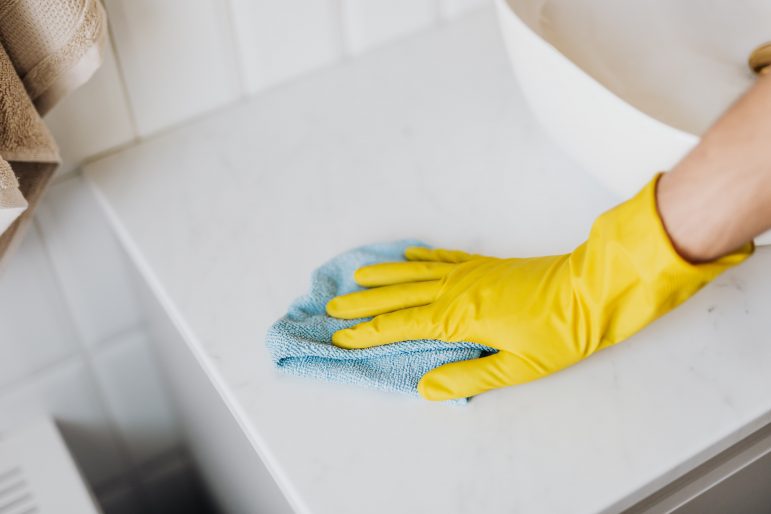Cleaning and disinfecting have become critical priorities for building and facility stakeholders. And, with little room for error, the pressure is on cleaning professionals to ensure environments not only appear clean but uphold the highest standards of hygiene. Here to discuss this evolving role and how healthcare industry leaders are rising to the challenge is Melissa Balinsky with A.M.G. Medical Inc.

A.M.G. Medical Inc.’s Melissa Balinsky
How have you seen the role of cleaning staff evolve throughout the pandemic?
I don’t think the role has changed, per se. If anything, the pandemic has heightened awareness of how important environmental services professionals are and how critical it is to protect them. Whether they’re in a school, hospital, office, or retail environment, people are more conscious of the fact that their health and wellbeing literally rests in their hands. Cleaning and disinfection are so top of mind that you can’t help but look at the staff charged with conducting those tasks with more respect and admiration.
You speak to your clients about the difference between cleaning and disinfecting often. Can you explain what separates these two activities?
People tend to lump cleaning and disinfection together, but they aren’t the same thing. The main difference is if you’re cleaning something, you can use a lot of sensory cues to guide you in identifying and addressing sources of dirt, dust, stains, and other noticeable items that require cleaning. You can touch the dust, you can see stains, and you can sometimes smell the debris and other elements. So, with cleaning, you really are using your senses to tell when the job is done.
Disinfection, on the other hand, is the exercise of killing and eliminating something that you can’t necessarily see or smell or hear. These can be harmful bacteria and viruses that, if missed or not fully disinfected, can remain on a surface for days, weeks, or even months. Unfortunately, you don’t really know they’re even there until people start getting sick, food starts to spoil, and bacterial odours begin to appear.
We have to remember that facility maintenance teams already have a lot on their plate. And, when they’re tasked with both cleaning and disinfecting a space, they are actually being tasked with very different and time-consuming exercises on top of their day-to-day responsibilities. So it’s helpful to understand the distinction between both of these activities in order to get the job done thoroughly and efficiently the first time out.
What is “contact time” and why is it important to the disinfection conversation?
Contact time refers to the amount of time a disinfecting agent needs to be acting on a pathogen like bacteria or a virus to kill it. Anything that is supposed to disinfect something has a contact time, whether it’s chemicals or UV light.
Think about a room with a single table, for example. A cleaning professional can’t just take out a wipe, rub the surface, and call it a day. Even if they are using a disinfectant with a contact time of five minutes, that means that every single spot on that table has to remain wet with the active ingredient for five minutes. Moreover, if they miss just one spot, they aren’t achieving total disinfection. Only places that come in contact with or are exposed to the disinfecting product or agent are accounted for.
Now, take a step back and think about how complex and time-consuming it can be to apply that level of effort to everything else in that room – every centimetre of every chair, door, fixture, or piece of furniture in the space. It becomes very daunting and stressful for maintenance teams that are already busy as it is, and also likely anxious about spending that amount of time in a potentially risky environment.
How have cleaning products and services evolved to capture that “bigger picture”?
There are several ways the industry is stepping up. There are people like myself working with facilities and cleaning professionals to understand the current risks, navigate the regulatory environment, and work through all the myths and misconceptions. We’re also adapting the way we share information by having our representatives consult with clients virtually instead of face-to-face meetings.
We’re also helping bring awareness to how our products can be used not just in high-risk environments like hospitals, but in schools, malls, stores, government facilities, and other public areas.
Our Nocospray Disinfection System, for example, is an automated room disinfection system that can disinfect an entire space on its own and with zero human interaction. Staff still need to conduct that initial clean, but this allows them to activate the system, leave the room, and focus on other tasks with confidence that the environment is being disinfected thoroughly. The System will address the hard-to-reach, often-forgotten areas – all the hard surfaces in the space. The idea is to reduce the amount of time individuals are being exposed to potentially contaminated environments while saving costs and ensuring more complete disinfection.
Again, both cleaning and disinfecting are critical, but when it comes to the disinfecting element, we need more awareness and tools like Nocospray to keep cleaning professionals and building stakeholders safe.
How do you see attitudes towards cleaning evolving beyond the pandemic?
Ultimately, the pandemic has caused a seismic shift in awareness. The level of panic will eventually subside, but the awareness of the value of attention to effective, accessible, and cost-effective disinfection won’t go anywhere.
We have seen other events have a big-bang effect on infection control products and concepts before. We don’t return to the baseline; we hold on to the change.
A.M.G. Medical is a Canadian-owned company focusing on the health of our valued customers. Please click Nocospray to learn more about this revolutionary disinfection system which is effective for all types of facilities. If you would like to discuss Nocospray or any other of our products, please feel free to call us at 1-800-361-2210.








